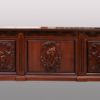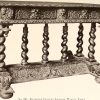Elegant, unique, and reminiscent of old times and long-gone craftsmanship, antique furniture brings style, individuality, and charm to any space. It is valuable from both a practical and an artistic standpoint – antique pieces are beautiful, exquisitely made, and high-priced, so many people see them not only as stylish additions to their homes, but also as long-term investments and treasured possessions.
If you’re considering buying an antique yourself, you have plenty of good options – from auction houses and flea markets to online vintage shops and Craigslist (not to mention specialized antiques stores and antiques fairs). But how do you know you’re purchasing a genuine article? How do you tell the difference between a hidden treasure and an item of little or no worth? How do you spot a great piece?
To avoid costly mistakes and find good bargains, you need to be well prepared when hunting for antiques – do a little research before you head out to shop and find out what makes an old piece an antique, how to assess the age and quality of a piece, how to determine if an item is worth its price, etc. When you know what to look for, you’ll be able to make a great deal and get a high quality piece at a very reasonable price.
So, when buying antique furniture, make sure you consider the following factors:
The Quality of the Piece
When an old furniture piece draws your attention, your first step is to see how it was made:
1) Material
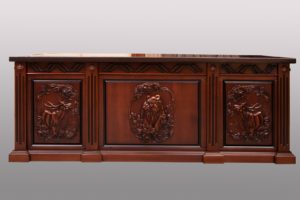
Antique furniture is made of high quality wood
Antique furniture is made of high quality wood – a single piece may be crafted with different types of wood, but it will be always be solid wood, not plywood. So, when examining an old furniture piece, look at the backside (and the insides and backs of drawers if applicable) – solid wood backing indicates the item is most likely made before the 1880s (plywood became popular at the beginning of the 20th century and particleboard was only used after the 1960s).
Also, keep in mind that antique furniture made of hardwoods (oak, walnut, mahogany, maple, etc.) is considered better quality than furniture made of softer woods like pine and rosewood. And uncommon woods are a hallmark detail to consider – some antique pieces are crafted from extremely rare woods, which drives up their value considerably.
If you are not experienced in detecting the type of wood on sight, check the weight of the furniture – if the piece is heavy for its size, it’s most likely made of solid hardwood.
2) Construction
Once you’ve determined the quality of the material, see if the furniture is well constructed – check the joints, the proportions of the piece, its balance and stability, etc. Make sure the furniture has “good bones” – the frame should be sturdy, the drawers should slide out easily, and the furniture elements should be symmetrical and balanced.
A well-constructed piece will be durable enough to last for generations and attractive enough to capture the attention of anyone who sees it.
3) Dovetail joints
The dovetail is a type of joint that was commonly used in the past to unite separate parts on a single piece of furniture. It’s most often seen on cabinets and inside drawers.
Dovetail joints are extremely strong and long lasting – they require great skill to produce, so dovetailing is considered a sign of a well-made piece. This construction detail is your first key to the piece’s age and quality of craftsmanship – handmade dovetails were common before 1890 and made by skillful and experienced artisans with genuine passion for their craft.
Dovetailing, however, is rarely perfect — since they’re handmade, dovetails aren’t likely to be evenly cut. In most cases, they’re slightly irregular and the pins are thin and tapered. Wider, uniform machine-cut dovetails were common in factory-made pieces from 1890 until the middle of the 20th century.
If you see dovetails, make sure you look on the inside of the drawer front as well (where it meets with the sides) – there should be larger cut marks (the so-called kerf marks). They are leftover marks that the saw created when the furniture maker was cutting out the dovetails in the drawer face to be attached with the drawer sides. Kerf marks are tell-tale signs of hand craftsmanship.
If a furniture piece has no dovetails, it is not likely to be an old piece with antique value – the furniture is probably held together with nails and glue, which is a sign it was made in a factory during the late 20th century.
Last but not least, you want to see an elegant design with intricate ornaments and refined carving that indicate exquisite craftsmanship and superior quality.
The Condition of the Piece
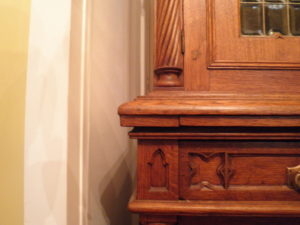
As a rule of thumb, case goods such as bookshelves, cabinets, and chests hold up better than upholstered furniture
The next thing to do before you buy antique furniture is to check its condition. Keep in mind though an item must be at least 100 years old to be considered an antique, so you can’t expect perfection – if a piece has lasted over 100 years, it’s going to show some wear and tear. In fact, “flawless” furniture means “new” furniture.
Still, you want to buy a piece in good condition – one that has been gently used and properly cared for, not an item that has been trashed and damaged. So, before you buy an old furniture piece, make sure you closely inspect its condition:
- If it is a small item, pick it up and turn it around and even upside down to make sure it has no hidden flaws. Check for woodworm – look for the tell-tale holes and dust coming out of the furniture;
- If it is a large item, walk around the entire piece and ask that it be pulled away from the wall, so that you can see it from all sides. Open all drawers and/or doors, look inside the furniture, study the back, check for loose joints, see if the drawers glide easily in and out (if not, the drawer runners might be worn and need replacing), etc.;
- If you’re buying a piece online, ask for pictures from different angles and a detailed description of the furniture.
Look for signs of age and wear, damages and repairs, natural patina, etc. Note wobbly legs, broken parts, cracks and stains. Keep an eye on the sales person while examining the piece – if they get nervous, something might be amiss. In such a case, you may want to reconsider your decision to buy the piece or, at least, have it inspected more closely.
As a rule of thumb, case goods such as bookshelves, cabinets, and chests hold up better than upholstered furniture. Yet, this type of furniture is usually quite heavy, so it is often pushed around rather than being lifted and moved which may have resulted in some damage.
When inspecting an old furniture piece, keep in mind that the part of the furniture that is subject to the most wear is most likely to be damaged. When buying a chair for example, you can expect wobbly legs and a worn out (or broken) back, upper portion, and center supports (known as the splats).
While it is important to buy an item that is in a good overall shape, minor surface scratches and cracks are not a considerable problem – they can be easily fixed and don’t necessarily affect the value of the piece (wood will expand and contract over time due to fluctuations in the ambient temperature and crack slightly in the process, so small nicks can be expected in pieces from the 17th, 18th, and early 19th centuries and they actually prove the piece’s age and authenticity).
If the piece is high quality, some minor damage should not discourage you from buying it – slightly damaged furniture can be easily repaired and restored to its original stability and beauty by professional antique furniture restoration experts. Your vintage piece will look and perform as well as it did when it was manufactured.
Good to remember: It’s very important to look for repairs and replacements when buying antique furniture – repairs are when original furniture parts have been fixed back onto the piece, while a replacement is when a damaged part has been fixed with an entirely new piece – an old top can be put onto a newer table base, broken legs, shelves, and backboards can be replaced with new ones, etc.
Replacements detract from the furniture value, so when inspecting a vintage piece you’re interested in, check if:
- the handles are original;
- there is some inconsistency of color or unexplained screw holes that indicate a furniture element has been replaced with a new one;
- there is any plywood or particleboard in the furniture – these materials were not used before the 20th century, so their presence is a clear sign that a section of the furniture has been recently replaced.
Replacement parts and added hardware significantly lower the value of antique pieces – a Chippendale desk with replaced legs, for example, will command a fraction of the price of a same style piece in original condition. In general, the less amount of restoration work done, the more valuable a piece is likely to be. Nevertheless, it’s fine to buy restored furniture, especially if you want to keep it for yourself and use it for many years to come – you will get a high quality piece at a very affordable price.
The Age of the Piece
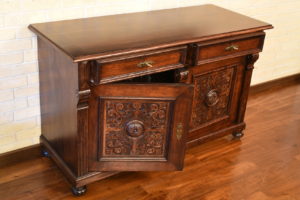
Antiques are valued not only for their high quality, aesthetic beauty, and exquisite workmanship, but also for their history
Antiques are valued not only for their high quality, aesthetic beauty, and exquisite workmanship, but also for their history. As already mentioned, an item must be 100 years old or more to be officially called an antique (vintage goods are about 50-40 old).
Therefore, when buying antique furniture, it’s very important to make sure that it is a genuine article. It is not easy to verify the actual age of a piece (some manufacturers use special techniques to make new furniture look old, others make skillful reproductions, etc.), so you need to be well familiar with the characteristic designs and styles of antique furniture, know common brands and makers from the past, and buy only from reputable sources (see below for more detailed information).
Here are some good indications of the age and authenticity of a furniture piece:
- Inscriptions and manufacturer’s stamps – Most old furniture pieces have a marking indicating their origin – it is usually found on the back or bottom of the furniture or on the inside of drawers. Handcrafted early pieces may even bear an inscription from an individual furniture maker – really old furniture often has a pencil signature on the inside of a drawer. Paper labels came into use at the turn of the 20th century and then progressed into brass plaques tacked onto the insides of drawers or on the back of a piece. In the 1950s and 1960s, furniture manufacturers were using spray-on stencils. Sometimes, however, you may not be able to find a stamp or signature, even if the furniture is a real antique – the inscriptions may have worn off over time or the piece may be a part of a furniture set that had only one of the pieces marked, etc.;
- Finish and patina – An original finish lends to the authenticity of an object and increases its value. Layers upon layers of dirt and dust and oils would have accumulated on the piece over the years, creating a smooth patina, so if the piece looks purple or blackish in color, it’s a sure sign that it still has its original finish. An antique is also expected to have a crazed or slightly cracked surface (as explained above). Both the patina and the small nicks are part of a piece’s history and indications of its old age;
- Original hardware – Solid cast-brass or wooden pulls are unmistakable signs of quality old furniture. When you look at the back of the handles, you should see a threaded post and a nut securing the brass to the drawer/door front. If there is no nut and you only see what looks to be the top of a slotted or flathead screw going towards the face of the furniture, this means that the hardware is new – which is also a good indication that the piece is not very old either;
- Construction details and dovetail joints, as explained above.
There are a few other details that can help you date a piece as well:
- Marble-top dressers and beds with giant headboards and footrests are almost exclusively from the late 1800s;
- Dressers with a mirror attached on a harp were made around the turn of the 20th century;
- Dressers with a separate mirror that hangs on the wall above the dresser typically date to the 1940s or later;
- High chair backs, trumpet-turned legs ending in a hoof or claw-like foot, and Asian lacquer work were popular in the 1700s;
- Fiddle-back backings, cabriole legs ending in a pad or drake foot, and batwing drawer pulls are characteristic of 18th century furniture;
- Any piece on casters (wheels) is typically pre-1930s.
The origin and the rarity of the piece are also important factors to consider when buying antique furniture. Needless to say, the rarer the piece and the more famous the manufacturer, the more valuable the furniture will be.
Good to know: Rare and highly valuable antiques should have provenance – proof of where the piece came from. It could include purchase receipts, professional appraisals, photographs and historic records, etc.
Where to Buy Antique Furniture
When it comes to antique furniture, it is of paramount importance to buy from a trustworthy and knowledgeable seller. You need to find a furniture dealer who is able to provide you with full details about the condition, age, origin, and maintenance requirements of a piece.
A vetted marketplace or fair – where every item has been inspected and approved by a group of experts before being put for sale – is one of your best bets. Everything is genuine and of sound quality, so you can’t make a mistake.
Buying from a member of one of the two key trade associations of antique furniture dealer, BADA and LAPADA, also provides reassurance on quality.
If you’re buying antique furniture online, look for reputable sites and inquire about the seller’s return policy before making a purchase.
If you’re buying antiques from auction houses, flea markets, or estate sales, you may be able to strike a better bargain, but there will be no guarantees of the quality or authenticity of the piece.
Now that you know what to look for when buying antique furniture, you should be able to make a good deal. Yet, it will be even better if you know how to buy antique furniture as well.
Bonus Tips for Buying Antique Furniture
- Buy antique furniture that you love – if a piece grabs your attention immediately, if it suits your personal style and aesthetic preferences, its market value should be of little concern for you. It is not an investment, but an item you will be living with and using daily, so it should be something you love. Even if a piece that calls to you is slightly damaged, you should not hesitate to buy it – any reputable antique furniture restoration specialist will be able to fix it and restore its original beauty and serviceability;
- Use scratches and any other evidence of damage to bargain for a better price. However, make sure the piece can be successfully fixed and the price of repairs won’t be too high before buying the furniture. Steer clear of items that are rickety or show signs of water damage;
- Take your home measurements with you to make sure that the furniture you buy will fit in – not just in the desired space, but also through the doors and corridors of your home;
- Measure the piece – check the actual dimensions of the item you like to determine whether or not it will work in your home. Furniture can always look too big or too small in a store – you need to make sure it is scaled right and complements the rest of your home décor (both in color and style);
- Act as if you’re an expert in antiques and know what you’re looking for. This will save you a lot of unnecessary sales talk and may even prevent fraudulent attempts;
- If you’re not sure whether an item is worth buying, get a second opinion – take several pictures of the furniture and send them to a trained appraiser who can tell you the actual value of the piece;
- Look for lesser known brands and furniture makers – they may not be as famous as other manufacturers of the same era, but their products may be just as good quality – only less expensive;
- Look for shops that have an antique piece on display but are not specialized in selling antique furniture. Chances are this will be a great bargain, as the owner is probably not an expert in the field and will sell the item at a lower cost;
- Visit vintage stores every now and again – they’re likely to reduce prices on pieces that have not sold after a certain period of time. If you check in often, you have a better chance to find a bargain;
- Always ask for discounts – most sellers include a 10-30% margin to all their items, so they may be willing to lower the price in order to make a sale (especially if you’re buying more than one item). Also, ask if there is an extra discount for paying with cash – almost every seller prefers cash, so this may work;
- Be sure to get a receipt – it has to state the age, wood type, style, and value of the antique furniture, as well as if there was any damage or restoration;
- Don’t forget to bring blankets and straps to safely pack your newly-bought antique furniture and transport it to your home without damaging it.
You will enjoy your beautiful antique furniture for years to come and its investment value will only increase with time.









